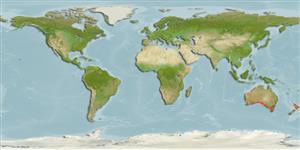Platycephalus bassensis Cuvier, 1829
Southern sand flathead
個人による観察記録の追加 Fish Watcher
| Native range | All suitable habitat | Point map | Year 2050 |

|
| This map was computer-generated and has not yet been reviewed. |
| Platycephalus bassensis AquaMaps Data sources: GBIF OBIS |
分類 / Names 共通名の | 類義語 | Catalog of Fishes(部類, 種) | ITIS | CoL | WoRMS | Cloffa
> Perciformes/Scorpaenoidei (Scorpionfishes) > Platycephalidae (Flatheads)
Etymology: Platycephalus: Greek, platys = flat + Greek, kephale = head (Ref. 45335).
More on author: Cuvier.
Etymology: Platycephalus: Greek, platys = flat + Greek, kephale = head (Ref. 45335).
More on author: Cuvier.
Environment: milieu / climate zone / depth range / distribution range 生態学
海; 汽水性の 底生の; 深さの範囲 1 - 100 m (Ref. 9563). Temperate; 30°S - 43°S
分布 国々 | 国連食糧農業機関の区域 | エコシステム | 事件 | Point map | 導入 | Faunafri
Indo-Pacific: known only from southern Australia.
Length at first maturity / サイズ / 重さ / 年齢
Maturity: Lm 23.5 range ? - ? cm
Max length : 46.0 cm TL オス/雌雄の選別がない; (Ref. 9563); 最大公表体重: 3.1 kg (Ref. 6390)
Max length : 46.0 cm TL オス/雌雄の選別がない; (Ref. 9563); 最大公表体重: 3.1 kg (Ref. 6390)
簡単な記述 検索表 | 形態学 | 形態計測学
脊つい: 18 - 20. This species differs from Platycephalus westraliae in having the following characters: both second dorsal and anal fin rays usually 14 (vs. 13), total gill rakers 18-20 (vs. 10); palatine with a tooth band comprised of several irregular rows of conical teeth (vs. with an inner larger conical and an outer smaller villiform tooth rows); caudal fin with several small pale brown spots on the upper lobe and one or two large dark brown or black spots on the lower lobe, and with concave posterior margin (vs. with 3 dark bands and with mostly straight posterior margin) (Ref. 86914).
Inhabit coastal waters from shallow bays and inlets to depths of about 100 m over sand, shell grit and mud substrates (Ref. 6390). Sand flathead are usually solitary but may form loose aggregations (Ref. 2165, 27247). They sometimes move long distances (Ref. 6390). They are active foragers and ambush predators (Ref. 6390), occasionally are scavengers (Ref. 6390). Feed on crustaceans and fish (Ref. 2165). Its fin spines are venomous, can inflict mild to severe pain (Ref. 125684).
Life cycle and mating behavior 成熟 | 繁殖 | 放精 | 卵 | 生産力 | 幼生
主な参考文献
Upload your references | 参考文献 | コーディネーター | 協力者
Paxton, J.R., D.F. Hoese, G.R. Allen and J.E. Hanley, 1989. Pisces. Petromyzontidae to Carangidae. Zoological Catalogue of Australia, Vol. 7. Australian Government Publishing Service, Canberra, 665 p. (Ref. 7300)
CITES
Not Evaluated
人間に対する脅威
Venomous (Ref. 125684)
Human uses
水産業: 商業
FAO - Publication: search | FishSource |
より多くの情報
Population dynamics
成長のパラメーター
Max. ages / sizes
Length-weight rel.
Length-length rel.
体長組成
Mass conversion
補充
豊度
成長のパラメーター
Max. ages / sizes
Length-weight rel.
Length-length rel.
体長組成
Mass conversion
補充
豊度
Anatomy
カマ
Brain
Otolith
カマ
Brain
Otolith
Physiology
Body composition
Nutrients
酸素消費
水泳形態
泳ぐ速さ
Visual pigments
Fish sound
Diseases & Parasites
Toxicity (LC50s)
Body composition
Nutrients
酸素消費
水泳形態
泳ぐ速さ
Visual pigments
Fish sound
Diseases & Parasites
Toxicity (LC50s)
Genetics
遺伝子の
Heterozygosity
遺伝
遺伝子の
Heterozygosity
遺伝
用具
E-book | 野外観察図鑑 | Length-frequency wizard | 生活史の基盤ツール | 目的のマップ | Classification Tree
| Catch-MSY |
特記事項
XMLをダウンロードして下さい
インターネットの情報源
AFORO (otoliths) | Aquatic Commons | BHL | Cloffa | BOLDSystems | Websites from users | Check FishWatcher | CISTI | Catalog of Fishes: 部類, 種 | DiscoverLife | ECOTOX | FAO - Publication: search | Faunafri | Fishipedia | Fishtrace | GenBank: ゲノム, ヌクレオチド | GloBI | Google Books | Google Scholar | Google | IGFA World Record | MitoFish | Otolith Atlas of Taiwan Fishes | PubMed | Reef Life Survey | Socotra Atlas | 生命の木 | Wikipedia: 行く, 検索する | World Records Freshwater Fishing | Zoobank | 動物に関する記録
Estimates based on models
Preferred temperature (Ref. 123201): 14.6 - 18.5, mean 17.1 °C (based on 242 cells).
Phylogenetic diversity index (Ref. 82804): PD50 = 0.5000 [Uniqueness, from 0.5 = low to 2.0 = high].
Bayesian length-weight: a=0.00417 (0.00330 - 0.00527), b=3.11 (3.04 - 3.18), in cm total length, based on LWR estimates for this species (Ref. 93245).
栄養段階 (Ref. 69278): 4.3 ±0.75 se; based on food items.
回復力 (Ref. 120179): 手段, 1.4年~4.4年の倍増期間の最小個体群 (K=0.19; tmax=9).
Fishing Vulnerability (Ref. 59153): Low to moderate vulnerability (29 of 100).
Nutrients (Ref. 124155): Calcium = 65 [6, 306] mg/100g; Iron = 0.792 [0.214, 2.004] mg/100g; Protein = 18 [16, 20] %; Omega3 = 1.01 [0.44, 2.67] g/100g; Selenium = 18.8 [5.0, 75.1] μg/100g; VitaminA = 25.4 [8.9, 72.5] μg/100g; Zinc = 0.651 [0.297, 1.378] mg/100g (wet weight);




